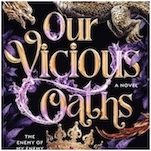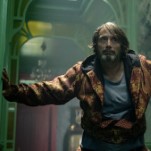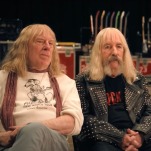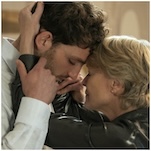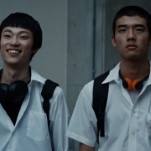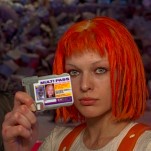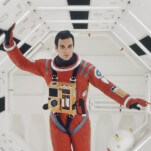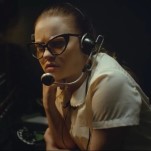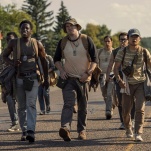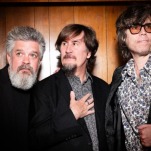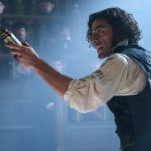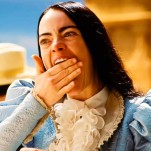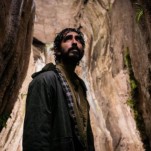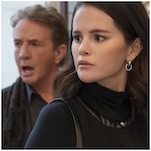The 20 Best Movies on Paramount+ Right Now
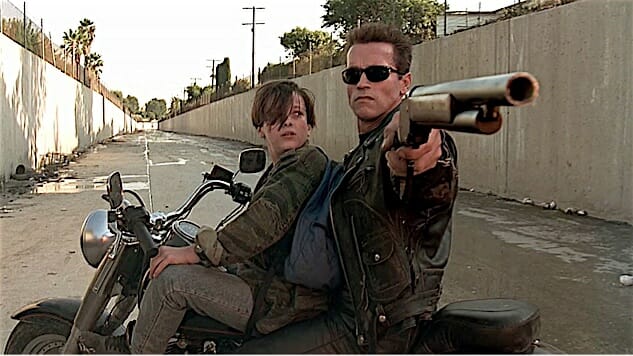
Paramount+, the streaming service that is to ViacomCBS what HBO Max is to WarnerMedia, is finally here. The company (and the studio that streamer takes its name from) is stuffing its library online. CBS All Access, which it is replacing, is dead. Yes, it’s another streamer and yes, it’s another streamer with a + at the end of its name. But hear us out: Paramount might be the new kid on the block, but the best movies on Paramount+ are a heck of a deal. Either $9.99 a month for the ad-free tier or $4.99 for ads gets you “2,500 movie titles,” and that’s not even mentioning the slew of TV shows that’re coming along for the ride. You can also slap Showtime on for some extra oomph if you want!
Between the Comedy Central Roasts, stand-up specials and seemingly endless documentaries, it can be hard to sift through. Never fear, though, because we’re here to sort through it all and find the cream of the crop—updating every month. The plethora of dramatic classics, martial arts movies, Star Trek entries and forgotten favorites make Paramount+ worth checking out—especially considering its relatively low price point.
Here are the 20 best movies available to stream on Paramount+ right now:
1. The Godfather
Year: 1972
Director: Francis Ford Coppola
Stars: Marlon Brando, Al Pacino, James Caan, Richard Castellano, Robert Duvall, Sterling Hayden, John Marley, Richard Conte, Diane Keaton
Rating: R
The definitive immigrant story/definitive American tragedy: These are the awful things we are forced to do, and this is whom we do them for. The best mob stories ask: “How do I take care of me and mine?” How far are you willing to go to protect your own? In The Godfather and its sequels, the story of the Corleone family becomes the centerpiece of a deep meditation on family and power. Francis Ford Coppola answers: Ultimately, you will lose one in the vain pursuit of the other. During the second film, Family don Michael’s (Al Pacino) wife Kay (Diane Keaton, unrecognizable in her youth) gets her one really powerful scene as she reveals to her husband that she had an abortion because she can’t bear the thought of raising another child in the mob. He wouldn’t understand, she rants, because of “this Sicilian thing that’s been going on for 2,000 years!” Before, we flash back to 1941 and the fight that results from Michael revealing his enlistment in the Marines to his family: either the beginning of his personal fall or one last reminder that he’s always viewed himself as apart, as better. True tragedy comes from a fatal, internal flaw, and something about this scene is meant to suggest his. His family leaves him in the room alone. The only other times that both Michael and Vito (Marlon Brando; Robert De Niro) are alone on screen in the films occur in the tense moments before they kill—always in explicit defense of the family. Flash forward to Michael on a park bench by himself —years later, after he’s driven away his wife and his sister and seen countless people killed, many by his own order. The lonely horn section of the waltz motif plays us out. Long before that, Michael asks his mother if a man can lose his family in the struggle to protect it. It’s a question we’ve already answered. These are the awful things we are forced to do, and this is whom we do them for. At least, for Coppola, that’s what we tell ourselves. —Ken Lowe
2. Terminator 2: Judgment Day
Year: 1991
Director: James Cameron
Stars: Arnold Schwarzenegger, Linda Hamilton, Robert Patrick, Edward Furlong, Joe Morton
Rating: R
That rare sequel that trumps its predecessor, James Cameron and co-writer William Wisher Jr. crafted a near-perfect action-movie script that flipped the original on its head and let Ahnold be a good guy. But it’s Linda Hamilton’s transformation from damsel-in-distress to bad-ass hero that makes the film so notable. Why should the guys get all the good action scenes? —Josh Jackson
3. Zodiac
Year: 2007
Director: David Fincher
Stars: Jake Gyllenhaal, Mark Ruffalo, Robert Downey Jr., Brian Cox, John Carroll Lynch
Rating: R
I hate to use the word “meandering,” because it sounds like an insult, but David Fincher’s 2007 thriller is meandering in the best possible way—it’s a detective story about a hunt for a serial killer that weaves its way into and out of seemingly hundreds of different milieus, ratcheting up the tension all the while. Jake Gyllenhaal is terrific as Robert Graysmith, an amateur sleuth and the film’s through line, while the story is content to release its clues and theories to him slowly, leaving the viewer, like Graysmith, in ambiguity for long stretches, yet still feeling like a fast-paced burner. It’s not Fincher’s most famous film, but it’s absolutely one of the most underrated thrillers since 2000. There are few scenes in modern cinema more taut than when investigators first question unheralded character actor John Carroll Lynch, portraying prime suspect Arthur Leigh Allen, as his facade slowly begins to erode—or so we think. The film is a testament to the sorrow and frustration of trying to solve an ephemeral mystery that often seems to be just out of your grasp. —Shane Ryan
4. Airplane!
Year: 1980
Director: Jim Abrahams
Stars: Lloyd Bridges, Peter Graves, Robert Hays, Julie Hagerty, Leslie Nielson
Rating: PG
Runtime: 179 minutes
The writing trio of Jerry Zucker, Jim Abrahams and David Zucker (ZAZ) defined a genre with their disaster-movie spoof in 1980. The jokes fly fast and furious, from the “Who’s on First” confusion of a crew that includes Roger and Captain Oveur (“Roger, Roger. What’s our vector, Victor?”) to Oveur (Peter Graves) asking a kid in the cockpit, “Joey, do you like movies about gladiators?” to an old lady translating jive (“Jive-ass dude don’t got no brains anyhow! Shiiiiit!”) to “stop calling me Shirley!” Ridiculous and ridiculously quotable, it’s the funniest spoof film of all time. —Josh Jackson
5. Jackass Forever
Year: 2022
Director: Jeff Tremaine
Stars: Johnny Knoxville, Steve-O, Chris Pontius, Danger Ehren, Wee Man, Preston Lacy, Zach Holmes, Jasper Dolphin, Rachel Wolfson, Sean McInerney
Rating: R
On paper, Jackass Forever operates in perfect sync with every other long-gap nostalgia sequel/revival being used to prop up various streaming services or the tenuous theatrical experience. It arrives 11 years and change after a second sequel to a movie based on (and very similar to) a TV series, brings back as much of its core cast as possible for more of the same and, in some cases, even circles back to revisit certain sequences from previous installments. Just like past versions, Jackass Forever opens with a more staged action sequence that seems designed to blow remaining budget money on a larger-scale expression of the project’s grody whimsy. It’s Jackass, again, again. Two factors help Jackass Forever mitigate this on-trend sameness, and then transcend it. One is the durability of Jackass itself, which—in case it has somehow escaped you—consists of ringleader Johnny Knoxville and assorted skater-adjacent goofballs performing a variety of stunts and pranks that blur the line between primitive sketch comedy and sophisticated geek show. The second factor also has to do with that longevity. Let any movie or TV series run long enough, and it will become at least in part about its own age, and while Jackass doesn’t get too cutely sentimental about how long these guys have been in each other’s lives and ours, it is unavoidably aware of that fact. In some sequences, Knoxville’s hair is a distinguished mussed gray; more than once, Steve-O brandishes and/or retrieves his false front tooth (“They’re dropping like flies,” he grins semi-ruefully). In an early sequence, Knoxville jokes about the camera needing to avoid capturing his bald spot. Spike Jonze, a longtime cohort who only occasionally makes on-camera appearances, rushes on with some spray paint to cover it up. These guys are well into their forties, and they’re still surprising each other with taser zaps, engaging in everyone-loses slapstick competitions and using each other to prop up bike ramps. This is, as the saying goes, a feature, not a bug. That affability goes a long way: More casual viewers’ mileage may vary on which stunts are laugh-out-loud funny and which are abjectly horrifying, and the rickety carnival rollercoaster ride works better when the other passengers—whether fellow audience members or the on-camera talent—are screaming and laughing along in equal measure. Knoxville himself feels more like a host than ever, jumping into the fray for select bits, including a hell of a curtain call for his closer. He’s been good in fiction films, but he never feels as comfortable onscreen as when he’s presiding over this particular brand of mayhem. He emcees every Jackass movie like he may never get the chance to do it again—an unspoken threat that looms larger than ever over this one. After all, it may not be physically feasible to keep this series going as a Richard Linklater or 7 Up-style chronicle of slapstick performance art. Then again, Forever is right there in the title.—Jesse Hassenger
6. Minority Report
Year: 2002
Director: Steven Spielberg
Stars: Tom Cruise, Samantha Morton, Colin Farrell, Max von Sydow
Rating: PG-13
The more we become connected, the more any sense of personal privacy completely evaporates. So goes Steven Spielberg’s vision for our near future, couched in the signifiers of a neo-noir, mostly because the veil of safety and security has been—today, in 2002 and for decades to come—irrevocably ripped from our eyes. What we see (and everything we don’t) becomes the stuff of life and death in this shadowed thriller based on a Philip K. Dick story, about a pre-crime cop John Anderton (Tom Cruise) whose loyalty and dedication to his job can’t save him from meaner bureaucratic forces. Screenwriters Scott Frank and Jon Cohen’s plot clicks faultlessly into place, buoyed by breathtaking action setpieces—metallic tracking spiders ticking and swarming across a decrepit apartment floor to find Anderton, the man submerged in an ice-cold bathtub with his eyes recently switched out via black market surgery, immediately lurches to mind—but most impressive is Spielberg’s sophistication, unafraid of the bleak tidings his film prophecies even as it feigns a storybook ending. —Dom Sinacola
7. Coming to America
Year: 1988
Director: John Landis
Stars: Eddie Murphy, Arsenio Hall, James Earl Jones, John Amos, Madge Sinclair, Shari Headley
Rating: R
If this Eddie Murphy and Arsenio Hall classic, care of their team-up with John Landis (Blues Brothers), consisted only of the barbershop scenes inside of My-T-Sharp and nothing else, it would still be one of the greatest comedies of all time. As Prince Akeem from the fictional African country of Zamunda, Murphy travels to the great United States of America to evade his arranged marriage and find true love (in Queens, obviously). Akeem encounters all of the wonders of black America, saturated with satirical twists—the black preacher (via Hall as the incomparable Reverend Brown), the club scene, the barbershop, hip-hop culture and Soul Glo, it’s all here—but cameos from actors like Cuba Gooding Jr., Samuel L. Jackson, Louie Anderson and Murphy’s Trading Places co-stars Don Ameche and Ralph Bellamy take the Coming to America experience to a whole new level. An excellent comedy and a great tribute to New York City, this story of a prince just looking to be loved is a must-see for everyone—including those of us who’ve already seen it. —Shannon M. Houston
8. A Quiet Place Part II
Year: 2021
Director: John Krasinski
Stars: Emily Blunt, Cillian Murphy, Millicent Simmonds, Noah Jupe, Djimon Hounsou, John Krasinski
Rating: PG-13
Serving as both prologue and epilogue to the original film, flashing back to the day the sound-averse killer aliens landed on Earth, A Quiet Place Part II is an exercise in diminishing returns. But thanks to the strengths of its core ensemble and returning director John Krasinski’s ability behind the camera, A Quiet Place Part II’s technical merits mostly drown out the franchise’s increasingly noisy flaws. Picking up directly after the first film, the surviving Abbott family—Evelyn (Emily Blunt), Marcus (Noah Jupe), Regan (Millicent Simmonds) and a nameless newborn—mourn the sacrifice of patriarch Lee (Krasinski) by abandoning their somewhat busted, partially ablaze post-apocalyptic compound in search of a mysterious bonfire they spot on the horizon. They’ve gotten pretty good at dealing with these monsters thanks to the discovery that they hate the frequency produced by Regan’s cochlear implant—though with that baby in tow and their home apparently no longer inhabitable (for some reason), the family’s clearly in need of a more permanent solution. Not only are the film’s actors so good that they sell ridiculous ideas or freshen familiar situations—Simmonds is still a standout, at once the most expressive and grounded of the group, while Murphy shifts with a dying animal’s dangerous melancholy—Krasinski understands how to play to their physicality, keeping a tight focus on small actions and their potentially large consequences. Yes, people are once again taking very slow footsteps. But when he’s telling stories through these silent, zeroed-in processes, climbing through a window can be far more compelling than an alien barreling through a train car. These sequences are the intimate, often breath-holding culminations of Krasinski’s audiovisual talents, which are showcased in the flashback scene in which he appears. Fittingly, it’s also the best scene in the movie. That leaves A Quiet Place Part II to be a charmingly unambitious, ultimately enjoyable step down of a sequel: A controlled expansion where novelty fades to reveal technical prowess and contempt starts peeking out behind familiarity.–Jacob Oller
9. The Wolf of Wall Street
Year: 2013
Director: Martin Scorsese
Stars: Leonardo DiCaprio, Jonah Hill, Margot Robbie, Matthew McConaughey, Kyle Chandler, Rob Reiner, Jon Favreau, Jean Dujardin
Rating: R
The decade’s been both kind and not so kind to good ol’ Marty, ten years of bad takes questioning his credentials for directing Silence, for denying Marvel movies the honorific of “cinema,” for forcing audiences to showers en masse following screenings of The Wolf of Wall Street. And yet it’s impossible to keep him down; he’s immune to controversy and he thrives on lively debate, which is why, at 70 years old, his chronicle of the life, times and crimes of Jordan Belfort (Leonardo DiCaprio)—a stock broker and inveterate fraudster who bilked over 1,000 schlemiels, suckers and saps out of billions (and got off easy)—feels like something an artist half his age directed. The Wolf of Wall Street is a pissed off film. It’s also a horny, pervy, brutal, an impeccably made and fundamentally hideous film. At every passing image, Scorsese’s white-hot rage burns around the edges of the frame. The director has his own beefs and conflicts with his Christian faith, but here his presence is felt as a furious deity sitting in judgment on the fun Belfort has screwing over his clients, two-timing his first wife, jerking around his second wife and doing more blow in three hours than Scorsese himself did in the 1970s and ’80s. The easy knock to make against this movie is that it endorses the finance bro culture it navigates over the course of its running time, because at no point does Scorsese impose manufactured morality on what happens in front of us; instead he plays the hits as Belfort wrote them, showing the audience exactly what Belfort did while running his company, Stratton Oakmont, and while running around on his spouses. That the film ultimately ends with Belfort out on the prowl again is the ultimate indictment: Being rich allowed this man to get away with financial murder, because being rich, in the end, makes everything better. “Being rich makes everything better,” for some, is the movie’s embraced philosophy, but The Wolf of Wall Street doesn’t appreciate displays of wealth unhinged. It reviles them. Scorsese puts energy into the film, a spring in its every greedy step; one could call such debauchery without consequences a “good time.” But The Wolf of Wall Street doesn’t care about that kind of time as much as it cares about hanging Belfort out to dry. —Andy Crump
10. The SpongeBob Movie: Sponge on the Run
Year: 2021
Director: Tim Hill
Stars: Tom Kenny, Awkwafina, Matt Berry, Snoop Dogg, Bill Fagerbakke, Clancy Brown, Tiffany Haddish, Carolyn Lawrence, Mr. Lawrence, Keanu Reeves, Danny Trejo, Reggie Watts
Rating: PG
There are many reasons why SpongeBob SquarePants has endured more than two decades of steadfast love and pop culture relevance. Part of it is the enduring positivity and ridiculousness of SpongeBob (Tom Kenny), Patrick (Bill Fagerbakke) and the entire populace of their world. The characters are self-referential, consistent to their defining traits and the writers have always created a duality of experience: Silliness for kids and a sly ascendance of wit that appeals directly to the older viewers. The mode in which the funny is served needs to have all of that present to work. Director/writer Tim Hill (who also wrote 2004’s original The SpongeBob SquarePants Movie) understands that in this first, all-3D presentation. Hill and his team of artists—including Mikros Image, which is responsible for the CGI animation—play it smart by introducing a subtle transition for the view in the opening of Sponge on the Run. Gorgeous, photorealistic CGI of the underwater world transitions to the familiar color palette and stylized look of Hillenburg’s corner of the ocean, just with more presence and tactile flourishes. From Gary’s snail slime coming across as tangible goop to scratches in Sandy Cheeks’ breathing dome, the movie doesn’t aim to overwhelm audiences with overt tech bells and whistles. Instead, it presents the characters and world as an opportunity to experience the familiar in a new light, like appreciating the miniscule scale of a 3D-generated Plankton in comparison to his explosive rage—which makes him all the more hilarious. As another evolution in the ongoing SpongeBob universe, The SpongeBob Movie: Sponge on the Run is a graceful and well-executed dip of the yellow toe into 3D waters. There’s overall respect for the characters and tone, and artistic merit to how they integrate the medium into the show’s standards for presenting the surreal and strange. Does it push the sponge forward? Probably not, and that’s ok. There’s something timeless about Bikini Bottom remaining as it is, with spin-offs and new series serving as the appropriate playgrounds for new outlets of storytelling. Sponge on the Run lovingly splits the difference, but doesn’t take anything away from what many know and love.—Tara Bennett
11. The Virgin Suicides
Year: 1999
Director: Sofia Coppola
Stars: Kirsten Dunst, Kathleen Turner, James Woods, Giovanni Ribisi, Josh Hartnett
Rating: R
Set in the affluent Detroit suburb of Grosse Pointe, The Virgin Suicides is yet another Detroit-area, ’70s-era film obsessed with death. That its quintet of young protagonists—sisters played to unnervingly angelic perfection by Kirsten Dunst, A.J. Cook, Hanna Hall, Leslie Hayman and Chelse Swain—all commit suicide in the end is far from a surprise, of course: What is a surprise is that we never know why. In fact, the film is almost an oneiric procedural, in which the neighborhood boys who become infatuated with the strange daughters pick apart, piece by piece, detail by detail, the befuddling lives behind the objects of their affection. As such, The Virgin Suicides gracefully attempts to remember what it’s like to be a suburban teenager, comfortable in Middle America but uncomfortable with one’s body. Yet, the brilliance of Sofia Coppola’s direction (on even her first film) is in the way she laces such a seemingly innocent story with malice and melancholy, fixating on details that don’t matter or moments that have no consequence. That the narrator (Giovanni Ribisi) refers throughout to the decaying of the auto industry in Detroit makes the film as much a ghost story about Southwest Michigan as it is a tale of unrequited love: Try as hard as we might, we’ll probably never be able to trace the tragedy of Detroit back to its source. —Dom Sinacola
12. Bumblebee
Year: 2018
Director: Travis Knight
Stars: Hailee Steinfeld, John Cena, Jorge Lendeborg Jr., John Ortiz, Jason Drucker, Pamela Adlon, Dylan O’Brien, Angela Bassett, Justin Theroux, Peter Cullen
Rating: PG-13
Paramount actually made a Transformers movie that’s a lovely, exciting and wholly engaging gem of a sci-fi adventure for teenagers. I guess it’s time for me to finally go into my dream business of exporting the newly formed ice from hell using my army of flying pigs. Bumblebee is an ’80s set spin-off/prequel to Michael Bay’s migraine-inducing, often infuriating, and always head-slappingly stupid five Transformers flicks. It wisely scales down Bay’s love of random mayhem in favor of a fairly respectful and inventive throwback to those Spielbergian family sci-fi/adventure movies about the friendship between a nerdy, lonely teenager (Hailee Steinfeld) and a friendly and protective alien/robot/magical being. Their bond teaches the teenager to come out of her shell and face her fears. Of course since we also need an action-heavy third act, the big bad military that’s unfairly threatened by the creature goes after it, forcing the teenager and the creature to defend each other against all odds, learning lessons about the importance of love in the process. Sure, Bumblebee doesn’t really bring much that’s especially new or daring to that formula, but at least all the ingredients really work. It’s hard enough to have a fully CG character as your co-star, and it’s even tougher when an actor is tasked with creating a deep emotional connection with something she can’t even see during production. Steinfeld is up to the challenge, making us believe in Bumblebee’s existence almost as much as the animators who worked on bringing him to life. Just like death and taxes, it’s a certainty of life that we will get a new Transformers in theaters once every few years. If they’re more like Bumblebee going forward, the thought of that doesn’t depress me nowhere near as it used to. —Oktay Ege Kozak
13. Vanilla Sky
Year: 2001
Director: Cameron Crowe
Stars: Tom Cruise, Cameron Diaz, Penelope Cruz, Kurt Russell, Jason Lee, Noah Taylor
Rating: R
Cameron Crowe’s follow-up to Almost Famous was confusing, aching and beautiful, and the music and that played throughout its disorienting scenes—eerie selections from Radiohead, Sigur Rós and Jeff Buckley, plus oddly jaunty moments thanks to Peter Gabriel Todd Rundgren—perfectly augmented that off-kilter mood. As a bonus, Crowe tossed Sigur Rós in the mix three years before Steve Zissou and his crew confronted the jaguar shark to the tune of “Staralfur.”—Rachael Maddux
14. Star Trek Into Darkness
Year: 2013
Director: J.J. Abrams
Stars: Chris Pine, Benedict Cumberbatch, Zachary Quinto, John Cho, Alice Eve
Rating: PG-13
After a well-received re-whatever the Kelvin universe is, Star Trek Into Darkness might seem a ready-made blockbuster and classic, but though it did count as the former, it’s tough to ascribe to it the latter. Too often, director J. J. Abrams relies on awkward dialogue that doubles as director subtitles for character arcs and plot developments. (A second insertion/reminder of what will be the deus ex machina for one of those developments is particularly ill-executed.) And, though laden with enough plot points to serve as a potent meditation on the dangers of losing one’s way in the name of countering the threat posed by an Other, Star Trek Into Darkness doesn’t so much wrestle with such issues as give them a swat on the butt in passing. Granted, that’s not necessarily inconsistent with Roddenberry’s universe, where humanity’s better angels rule in the end (alternate timeline or no). For all the photon torpedoes, warp drives and matter transmitters, that optimism regarding human nature may be the most fantastical element of all. —Michael Burgin
15. Sonic the Hedgehog 2
Year: 2022
Director: Jeff Fowler
Stars: James Marsden, Ben Schwartz, Tika Sumpter, Natasha Rothwell, Adam Pally, Shemar Moore, Colleen O’Shaughnessey, Lee Majdoub, Idris Elba, Jim Carrey
Rating: PG
Director Jeff Fowler’s Sonic the Hedgehog 2 dashes forward as a sequel that pleases as any continuation should. Momentum carries over, fan-favorite characters enter the fray and the filmic universe’s presence embiggens. The first Sonic the Hedgehog is an adorable buddy comedy about an alien blur and his Donut Lord protector. Sonic the Hedgehog 2 feels more akin to Sonic’s videogame adventures by teaming with Tails, facing Knuckles and hunting the Master Emerald. It’s a comforting videogame adaptation: Heartwarming childhood lessons will delight all ages as Sonic leaves his origin blueprints behind to become the next-stage hero once projected from black plastic Sega cartridges. Eat your heart out, Mario. Jim Carrey continues his domination as the mustache-twirling villain Dr. Robotnik who flosses, giving another masterclass in physical comedy and conveying more range through his facial acting than entire comedy troupes. Carrey is an unstoppable force drawing from his glorious ‘90s catalog, especially when the action kicks into gear and his gesticulating goofiness translates to a Pacific Rim situation. There’s no shock on my face as I type these words: It’s so fulfilling to see Carrey play this kind of off-the-wall lunatic again. All this would be nothing without clean animation, and Sonic the Hedgehog 2 picturesquely impresses. Kudos to the collaborative efforts of Marza Animation Planet, Moving Picture Company and DNEG—the blending of live-action and computerized creatures is essentially immaculate. The quills and furs in blazing reds, the deepest blues and warm yellows are vividly detailed, and destruction that spans Green Hills to Hawaii could rival most blockbuster disaster flicks. Fans of Sonic the Hedgehog are in good hands with Sonic the Hedgehog 2. Fowler quietly sets the most recent bar for videogame adaptations by building a cinematic universe that speaks eloquently of childhood experiences through Sonic’s adrenaline-junkie antics. The addition of Tails and Knuckles is a dynamic level-up that will have fans craving more, not to mention the pop in my theater during the film’s mid-credits scene. Sonic the Hedgehog 2 might momentarily lose itself to for-the-kids wackiness, which certainly leaves some plotlines frayed, but the reasons we’re here—Knuckles, Tails, Sonic, more Eggman—are all enthusiastically respected. I’m a happy Sonic fan after Fowler’s high-speed sequel.—Matt Donato
16. The Lost City
Year: 2022
Director: Adam Nee, Aaron Nee
Stars: Sandra Bullock, Channing Tatum, Daniel Radcliffe, Da’Vine Joy Randolph, Oscar Nuñez, Patti Harrison, Bowen Yang
Rating: PG-13
After the death of her husband, the last thing smartypants archaeologist-turned-paperback-romance-author Loretta Sage (Sandra Bullock) wants to do is leave her house, let alone go on a book tour at the behest of her caring but pushy publisher/publicist Beth (Da’Vine Joy Randolph) and painfully millennial social media manager Allison (Patti Harrison, a star). Being a trouper, Loretta suits up into her uncomfortable glittery purple jumpsuit (it’s on loan) and begrudgingly puts on a fake smile onstage next to Alan (Channing Tatum), the well-meaning but dimwitted (and yes, hot) himbo cover model who portrays the hunky leading man of Loretta’s books, Dash McMahon. While the explosive, action-packed sequences are a lot of fun, and an essential element of the adventure genre, what sets The Lost City apart from recent, more tired blockbuster adventure/comedy fare (looking at you, Uncharted) is the humorously human moments that lead to a genuine connection between Loretta, Alan and the audience. Instead of falling back on the kind of semi-ironic “so, that happened” style of fourth-wall-breaking writing, directors and co-writers Adam and Aaron Nee take familiar adventure/rom-com cornerstones and repurpose them to find previously undiscovered gems through these personal moments. They are certainly aware of the tropes being toyed with here—dumb guy/smart lady romance, the frame story of Loretta’s novels, the treasure-hunting villain—but they approach these tropes with a freshness that gets the audience invested in its characters. The Lost City might follow conventional genre beats, but an expert cast with a stellar sense of humor and fresh writing leads to lots of laughs and a romantic adventure that turns out to be a diamond in the rough.—Katarina Docalovich
17. Mission: Impossible
Year: 1996
Director: Brian De Palma
Stars: Tom Cruise, Jon Voight, Henry Czerny, Emmanuelle Béart, Jean Reno, Ving Rhames, Kristin Scott Thomas, Vanessa Redgrave, Emilio Estevez
Rating: PG-13
Yup—stop for a minute and contemplate that the first M:I film was directed by Brian De Palma. A guy known more for art house thrillers and anti-heroes helms the first in a possible franchise starring an A-list actor (before Hollywood was only interested in franchises), not to mention the first film Cruise ever produced, a risk in and of itself. And yet, it all worked: Mission: Impossible is a plot-heavy, intelligent, patient action film, establishing a cypher of an action star who would go on to perfectly serve every single director to come. By now, it’s expected that with every new film in the franchise, Tom Cruise will step up his stuntman game, and every new director will be given the chance to interpret Ethan Hunt as he (or she, we can only hope) sees fit. In Mission: Impossible – Rogue Nation, Cruise asserts himself as perhaps the world’s most prominent asexual action hero, but 20 years ago no one had any idea what kind of conceptual framework he was putting into place. Mission: Impossible was a new breed of blockbuster action film, and the franchise’s longevity is clear evidence that, no matter what’s happened since, Tom Cruise is a guy whose risks seem to always pay off.—Dom Sinacola
18. Top Gun: Maverick
Year: 2022
Director: Joseph Kosinski
Stars: Tom Cruise, Jenifer Connelly, Miles Teller, Jon Hamm, Monica Barbaro, Ed Harris, Val Kilmer, Jay Ellis, Glen Powell, Lewis Pullman, Danny Ramirez, Greg “Tarzan” Davis
Rating: PG-13
Not quite four years since Mission: Impossible—Fallout and much of Tom Cruise’s purpose remains the same—if it hasn’t exactly grown in religious fervor. In Top Gun: Maverick, the sequel to Tony Scott’s 1986 original, Cruise is Captain Pete “Maverick” Mitchell, a man trapped in the past, refusing to advance his career as resolutely as he refuses to do much of anything besides continue to prove he’s the greatest pilot in the world—a title the film never forgets to remind the audience that Maverick earned long ago—and mourn his best friend, Goose (Anthony Edwards), who died 35 years ago in an accident for which Maverick still feels responsible. Tom Cruise is also, simply, “Tom Cruise,” the only notable show business scion left to throw his body into mind-numbing danger to prove that it can be done, to show a younger generation that this is what movies can be, what superstars can do. Must do. The more modern action films teem with synthetic bodies bursting apart at the synthetic seams, the more Tom Cruise builds his films as alters upon which to splay his beautiful sacrificed flesh. To that end, Joseph Kosinski is the precisely correct director to steer Cruise’s legacy sequel. As was the case with Kosinski’s Tron: Legacy, Maverick seems to exist to justify its existence, to update an IP that seems to only work in the past. For Top Gun this means translating Scott’s vision of sweat-drenched beach volleyball and unmitigated military spectacle into a soberer IMAX adventure, moving from the halcyon days of Reagan’s America to a world with no more need of a man like Maverick. “The future’s coming, and you’re not in it,” he’s told; every one of his superior officers appears to have no patience for him left. One can’t help but imagine that every new Tom Cruise vehicle is a way for him to reckon with that. Kosinski’s dogfights are pristine, incredible feats of filmmaking, economical and orbiting around recognizable space, but given to occasional, inexplicable shocks of pure chaos. Then quickly cohering again. If Scott’s action was a melange of motion never meant to fully cohere, keeping the American dream just that, then Kosinski is dedicated to allowing the audience a way into the experience. With his regular cinematographer Claudio Miranda, he revels in symmetry to keep the audience tethered. A wide glimpse of a dogfight in total, resembling a beach scene earlier, so suddenly appeared silently in the vast theater and unlike anything I’d ever really seen before, I gasped.—Dom Sinacola
19. Teenage Mutant Ninja Turtles: Mutant Mayhem
Year: 2023
Director: Jeff Rowe, Kyler Spears (co-director)
Stars: Micah Abbey, Shamon Brown Jr., Brady Noon, Nicolas Cantu, Jackie Chan, Ice Cube
Rating: PG
A visual tour de force of hybrid 2D and 3D animation, Mutant Mayhem is not only the most authentically New York version of the Turtles yet, it’s arguably the most inventive. Rowe, Spears and production designer Yashar Kassai have rendered the brothers as if they’re hand-drawn, complete with messy sketch lines, doodle flairs and a graffiti aesthetic. This is the ultimate paint-outside-the-lines take on the Turtles and it works on every level. Teenage Mutant Ninja Turtles: Mutant Mayhem is swinging for the fences with its story and voice performances to ambitiously, quantifiably shake up the artistic rut that theatrical computer animation has been stuck in for the last two decades. Another plus is that the brothers are voiced by non-adult voice actors Nicolas Cantu (Leo), Brady Noon (Raph), Shamon Brown Jr. (Mikey) and Micah Abbey (Donnie), who recorded together, and were encouraged to excitedly talk over one another like a gaggle of real, tight-knit brothers would do. It translates into rapid-fire, organic quips and seemingly effortless timing that conveys a rapport that is singular to this iteration. It also elevates the script so that it doesn’t sound like it was written by a bunch of 40-year-olds trying to be hip and young. Rowe and Spears have a firm hold on their pacing, especially in how they use comedy to enhance their action beats. They also chart a progression to the brother’s battle prowess that is satisfying and pays off in satisfying full-circle moments. There’s also much to be admired in their choice to frame a lot of sequences with hand-held camera blocking, which leans into the unpredictable youth of the heroes that works so well in the gritty New York environs they’re sparring in. The filmmakers are also delightfully experimental throughout the Mutant Mayhem, using inspired live-action inserts, segueing into different artistic styles (including a homage to Eastman and Laird’s comic art) and embracing the asymmetrical character design that gives the film a fresh and energetic looseness. Rowe and company prove that there’s no strength to the myth of IP fatigue when you have the vision and passion to reinvent with such bold and fun intention.—Tara Bennett
20. Mission: Impossible – Ghost Protocol
Year: 2011
Director: Brad Bird
Stars: Tom Cruise, Paula Patton, Jeremy Renner, Simon Pegg
Rating: PG-13
After the thrilling opening sequence of Mission Impossible: Ghost Protocol, we cut to a Moscow prison where Ethan is mysteriously being held. Agents Benji Dunn (Simon Pegg) and Jane Carter (Paula Patton) are plying their tech and explosives skills to break him out. The scene is jaunty and light-hearted, and scored, in the film’s reality, to Dean Martin’s “Ain’t That a Kick in the Head.” Light fuse. Cue famous theme. What follows is still the best entry in the Mission Impossible franchise, and one of the best action movies of the last decade. Not bad for first-time live-action director Brad Bird, though with his widely acclaimed previous work on animated features The Iron Giant, and Pixar’s The Incredibles and Ratatouille, it’s not a huge surprise. Ethan and his thrown-together team (including late-to-the-game IMF analyst William Brandt, played by Jeremy Renner) find themselves on their own with limited resources when their infiltration of the Kremlin goes horribly wrong and the IMF is blamed. This causes the U.S. government to invoke the titular spectral protocol, in which the entire agency is disavowed in order to avoid a war much worse than a Cold one with Russia. From there, it’s a global cat-and-mouse game with a megalomaniacal arms dealer who’s attempting nothing less than to wipe the Earth clean to start the cycle of life anew. Cruise is as electric as ever, and Ghost Protocol is wholly satisfying, and a breathtaking blast from start to finish. —Dan Kaufman
